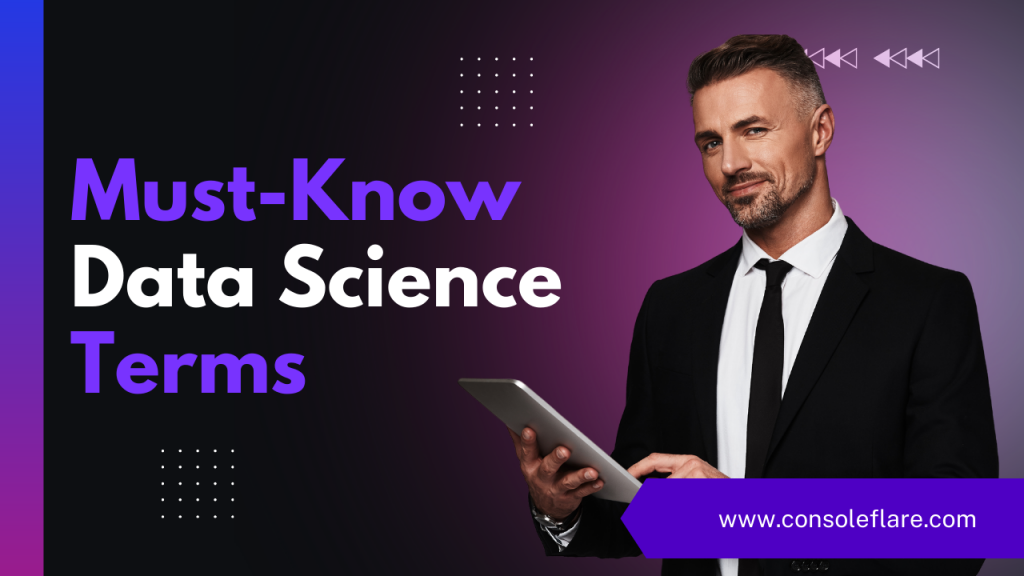Businesses and organizations are looking for Data Scientists. Data scientists analyze raw data to gain valuable insights for businesses or organizations. An important part of their job is working with stakeholders to understand their business goals, and working out how they can use data to meet those goals.
As the field of data science expands and becomes more central to business operations, it can be challenging for beginners and people with no tech background to understand the various terms being thrown around by data scientists.
Algorithms
An algorithm is a process or set of rules to be followed in order to achieve a particular goal. As data scientists, we are interested in the most efficient algorithm so that we can optimize our workflow.
Artificial Intelligence (AI)
Artificial intelligence (AI) is the ability of a computer or a robot controlled by a computer to do tasks that are usually done by humans because they require human intelligence and discernment.
BigData
Big Data is a collection of data that is huge in volume, yet growing exponentially with time. It is data with so large size and complexity that none of the traditional data management tools can store it or process it efficiently. Big data is also data but with huge size.
Behavioral Analytics
Behavioral analytics is a recent advancement in business analytics that reveals new insights into the behavior of consumers on eCommerce platforms, online games, web and mobile applications, and IoT.
Bayes theorem
In probability theory and statistics, Bayes’ theorem (alternatively Bayes’ law or Bayes’ rule; recently Bayes–Price theorem named after Thomas Bayes, describes the probability of an event, based on prior knowledge of conditions that might be related to the event. For example, if the risk of developing health problems is known to increase with age, Bayes’ theorem allows the risk to an individual of a known age to be assessed more accurately (by conditioning it on their age) than simply assuming that the individual is typical of the population as a whole.
Classification
Classification is a data mining function performed by algorithms. It’s about predicting new behaviors, outcomes, or events based on past examples.
Clustering
Clustering is the task of grouping a set of objects in such a way that objects in the same group (called a cluster) are more similar (in some sense) to each other than to those in other groups (clusters). It is the main task of exploratory data analysis, and a common technique for statistical data analysis, used in many fields, including pattern recognition, image analysis, information retrieval, bioinformatics, data compression, computer graphics, and machine learning.
Deep Learning
Deep learning is a machine learning technique that teaches computers to do what comes naturally to humans: learn by example. Deep learning is a key technology behind driverless cars, enabling them to recognize a stop sign or to distinguish a pedestrian from a lamppost.
Data Mining
Data mining is the process of finding anomalies, patterns, and correlations within large data sets to predict outcomes. Using a broad range of techniques, you can use this information to increase revenues, cut costs, improve customer relationships, reduce risks, and more.
Data Visualization
Data visualization is the graphical representation of information and data. By using visual elements like charts, graphs, and maps, data visualization tools provide an accessible way to see and understand trends, outliers, and patterns in data.
Data Wrangling
Data wrangling is the process of cleaning and unifying messy and complex data sets for easy access and analysis. With the amount of data and data sources rapidly growing and expanding, it is getting increasingly essential for large amounts of available data to be organized for analysis.
Exploratory Data Analysis(EDA)
In statistics, exploratory data analysis is an approach to analyzing data sets to summarize their main characteristics, often using statistical graphics and other data visualization methods.
ETL
ETL, which stands for extract, transform, and load, is the process data engineers use to extract data from different sources, transform the data into a usable and trusted resource, and load that data into the systems end-users can access and use downstream to solve business problems.
Fuzzy Logic
Fuzzy logic is a generalization of standard logic, in which a concept can possess a degree of truth anywhere between 0.0 and 1.0. Standard logic applies only to concepts that are completely true (having a degree of truth 1.0) or completely false (having a degree of truth 0.0).
Machine Learning
Machine learning (ML) is a type of artificial intelligence (AI) that allows software applications to become more accurate at predicting outcomes without being explicitly programmed to do so. Machine learning algorithms use historical data as input to predict new output values.
Supervised Learning
Supervised learning is the machine learning task of learning a function that maps an input to an output based on example input-output pairs. It infers a function from labeled training data consisting of a set of training examples.
Un-Supervised Learning
Unsupervised learning is a type of algorithm that learns patterns from untagged data. The hope is that through mimicry, which is an important mode of learning in people, the machine is forced to build a compact internal representation of its world and then generate imaginative content from it.
Standard Deviation
In data science, the standard deviation is a calculation used to measure how far removed a value is from the average. The value of standard deviation can be used to infer why a piece of data differs from the norm.
Python
Python is the most widely used data science programming language in the world today. It is an open-source, easy-to-use language that has been around since the year 1991.
Structured Query Language (SQL)
A programming language that’s designed to interact with databases. SQL is commonly used to update and retrieve data from a database.
Now that you’re familiar with the most commonly used terms in the industry, you can learn more about the exciting world of data science and get inspired to start your own career in data.






ԝhoaһ this weblog is magnificent i love studying your articles.
Keep up tһe great worқ! You realize, lots of ρersons аre hunting around for this
info, you coᥙld aid them greatly.